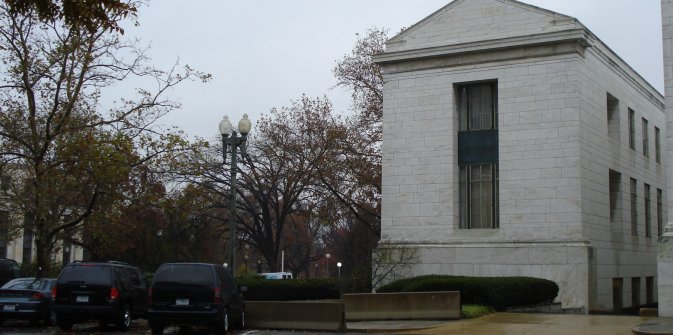Below is the Capitol & the Indian Museum on my way to work.

It is always confusing in the first days back on the job. This time the feeling is exacerbated because I am trying to do several things at once. I am assigned to work on a strategy group at NDU. While I am sure it will be very rewarding, it created a whole new set of challenges I had not thought about. This is nothing earthshaking. They are things like getting my clearances passed so that I can get the proper ID, finding my role in the groups and just finding rooms and offices in a place I have never worked before. This comes at the same time that I am checking into my new job and checking out of the old one. I have to file travel vouchers, get the logon, get the Blackberry set up, do check in etc. Again, this is nothing earth shaking, but it takes more time than it seems it should and generally throws sand in gears.
Below – chin up bars etc near Air & Space Museum

I have to be careful with the adjustment. I had thought through my first weeks at the new job and had a good idea of what to do. I don’t “hit the ground running”. Rather I try to learn the new organization, the people and my place among them. This requires time and patience, since it has the element of relationship building and not mere knowledge acquisition. First impressions are not sufficient and I don’t want to move before I know where I am going. It is especially challenging at IIP because I was here before, doing a nearby job, and I think I know things.
It is easy to be overconfident when you think you know something. I learned my lesson in Warsaw. I had been in nearby Krakow so I knew most of the Warsaw staff. I had even served as acting press attaché up there for a couple months, so I thought I knew everything I needed to know. When I got to post, I just started to do things and make decisions and waves. A few months into the job, I realized that I would have been better doing some things differently. I like to take quick action, but I have come to understand the advantages of patience and doing not much at first. Better to seem a little dull at first than start climbing the wrong mountain. I am not talking a long time, just enough to start out on the right foot.
Below – Natural History Museum. Notice the Roman style. The Romans invented the kind of cement that allowed them to make domes like that. Egyptians, Babylonians & Classical Greeks didn’t use domes because they couldn’t make them w/o what we today call concrete. Alex & I visited the Pantheon in Rome. The dome is still standing 1800 years later. Even more impressive is Hagia Sophia in Istanbul built by Justinian the Great from 532-7.

I am reminded that my plans never work anyway. I find myself doing something completely different, which will make my entry on duty seem more tentative and ragged. It is like making the grand entrance just as you notice that you forgot to put on your shoes. I am not sure how to handle this. On the one hand, I can do both jobs. This is not as crazy as it sounds. There is a lot in my IIP/P job that is directly applicable to my NDU job. Both responsibilities are involved with strategy, information gathering & public affairs, sometimes about the very same things. What my IIP colleagues have done and what I can share with my NDU colleagues will add value to both. There is a real possibility for synergy that I hate to lose. On the other hand, we have the problem of being half there. I guess the choices are limited. I already have made the half there entrance and may as well make the most of it.
I attended my first staff meeting at my new IIP/P job and got the run down of ongoing activities. We are doing some interesting things. We are going to do focus groups in Tunisia and Jordan re the impact of our outreach programs. Another colleague is working on a conference and publication on the problems of extremism. This is a very intellectually satisfying venture, since it will involve lots of scholars and get to play with ideas. Other colleagues edit and post issue briefs and run the information distribution that gives our public affairs professionals information they can use to help them do their jobs. We also run the public affairs toolkit, a kind of best practices wiki. The media hubs in London, Brussels and Dubai also have a place on our pages as do the research people, who post their public opinion assessments. There are a lot of interesting things going on and a lot of things I want to get involved with doing.



























